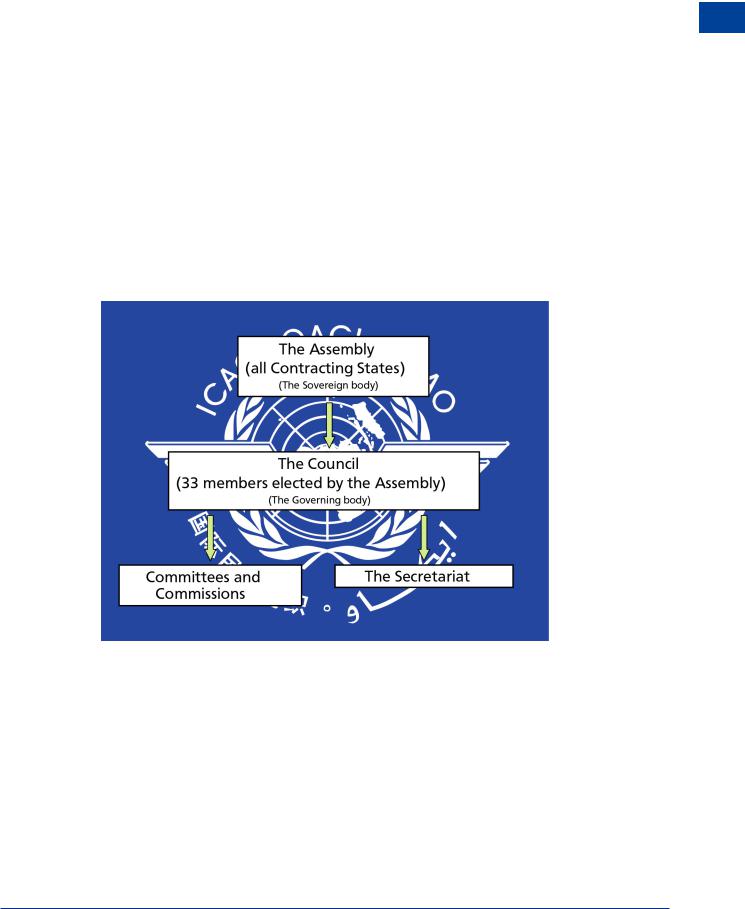
- •Textbook Series
- •Contents
- •1 Definitions
- •Introduction
- •Abbreviations
- •Definitions
- •2 International Agreements and Organizations
- •The Chicago Convention
- •International Law
- •Commercial Considerations
- •Customs and Excise, and Immigration
- •International Obligations of Contracted States
- •Duties of ICAO Member States
- •Status of Annex Components
- •The International Civil Aviation Organization (ICAO)
- •The Organization of ICAO
- •Regional Structure of ICAO
- •Regional Structure and Offices
- •ICAO Publications
- •Other International Agreements
- •The Conventions of Tokyo, the Hague and Montreal
- •The Warsaw Convention
- •The Rome Convention
- •IATA
- •ECAC
- •EASA
- •Eurocontrol
- •World Trade Organization
- •Geneva Convention
- •EU Regulation 261/2004
- •Questions
- •Answers
- •3 Airworthiness of Aircraft
- •Introduction
- •Airworthiness
- •Questions
- •Answers
- •4 Aircraft Nationality and Registration Marks
- •Introduction
- •Nationality and Registration Marks
- •Certification of Registration
- •Aircraft Markings
- •Classification of Aircraft
- •Questions
- •Answers
- •5 Flight Crew Licensing
- •Introduction
- •Definitions
- •General Rules Concerning Licensing
- •Licences and Ratings for Pilots
- •Multi-crew Pilot Licence (MPL)
- •Instrument Rating (Aeroplane) (IR(A))
- •Instructor and Examiner Rating
- •JAR-FCL 3 Medical Requirements
- •Pilot Proficiency
- •EASA Theoretical Knowledge Examinations
- •Questions
- •Answers
- •6 Rules of the Air
- •History
- •Applicability of the Rules of the Air
- •General Rules
- •Visual Flight Rules
- •Instrument Flight Rules
- •Semi-circular Flight Level Rules and RVSM
- •Special VFR
- •Distress and Urgency Signals
- •Restricted, Prohibited or Danger Areas
- •Signals for Aerodrome Traffic
- •Marshalling Signals
- •Flight Deck Signals
- •Questions
- •Answers
- •Instrument Procedures
- •PANS OPS
- •Instrument Departure Procedures
- •Questions
- •Answers
- •8 Approach Procedures
- •Procedure Basics
- •Approach Procedure Design
- •Obstacle Clearance Altitude/Height
- •Operating Minima
- •Descent Gradients
- •Track Reversal and Racetracks
- •Missed Approach Segment and Procedure
- •Published Information
- •RNAV Approach Procedures based on VOR/DME
- •Questions
- •Answers
- •9 Circling Approach
- •Circling Approach
- •Questions
- •Answers
- •10 Holding Procedures
- •Holding Procedures
- •Entry Sectors
- •ATC Considerations
- •Obstacle Clearance
- •Questions
- •Answers
- •11 Altimeter Setting Procedure
- •Altimeter Setting Objectives
- •Transition
- •Phases of Flight
- •Questions
- •Answers
- •12 Parallel or Near-parallel Runway Operation
- •Safety
- •Runway Spacing
- •Questions
- •Answers
- •13 SSR and ACAS
- •Airborne Collision Avoidance System (ACAS)
- •Questions
- •Answers
- •14 Airspace
- •Introduction
- •Control Areas and Zones
- •Classes of Airspace
- •Required Navigation Performance (RNP)
- •Airways and ATS Routes
- •Questions
- •Answers
- •15 Air Traffic Services
- •Introduction
- •Air Traffic Control
- •ATC Clearances
- •Control of Persons and Vehicles at Aerodromes
- •The Flight Information Service
- •The Alerting Service
- •Procedures
- •Questions
- •Answers
- •16 Separation
- •Concept of Separation
- •Vertical Separation
- •Horizontal Separation
- •Radar Separation
- •Procedural Wake Turbulence Separation
- •Radar Wake Turbulence Separation
- •Visual Separation in the Vicinity of Aerodromes
- •Stacking
- •Questions
- •Answers
- •17 Control of Aircraft
- •Procedural ATC
- •Radar Control
- •Radar Identification
- •Radar Service
- •Aerodrome Control
- •Approach Control Service
- •Air Traffic Advisory Service
- •Aircraft Emergencies
- •Questions
- •Answers
- •18 Aeronautical Information Service (AIS)
- •Introduction
- •General
- •The Integrated Aeronautical Information Package
- •The Aeronautical Information Publication (AIP)
- •Notices to Airmen (NOTAM)
- •SNOWTAM
- •ASHTAM
- •Aeronautical Information Circulars (AICs)
- •Pre-flight and Post-flight Information
- •Questions
- •Answers
- •Introduction
- •Aerodrome Reference Code
- •Glossary of Terms
- •Aerodrome Data
- •Runways
- •Taxiways
- •Aprons
- •Questions
- •Answers
- •Requirements
- •Visual Aids for Navigation
- •Runway Markings
- •Taxiway Markings
- •Signs
- •Markers
- •Visual Docking Guidance Systems
- •Questions
- •Answers
- •21 Aerodrome Lighting
- •Aerodrome Lights
- •Approach Lighting Systems
- •Runway Lighting
- •Taxiway Lighting
- •Questions
- •Answers
- •22 Obstacle Marking and Aerodrome Services
- •Introduction
- •Visual Aids for Denoting Obstacles
- •Visual Aids for Denoting Restricted Use Areas
- •Emergency and Other Services
- •Other Aerodrome Services
- •Questions
- •Answers
- •23 Facilitation
- •Entry and Departure of Aircraft
- •Questions
- •Answers
- •24 Search and Rescue
- •Definitions and Abbreviations
- •Establishment and Provision of SAR Service
- •Co-operation between States
- •Operating Procedures
- •Questions
- •Answers
- •25 Security
- •Introduction
- •Objectives
- •Organization
- •Preventative Security Measures
- •Management of Response to Acts of Unlawful Interference
- •Further Security Information
- •Questions
- •Answers
- •26 Aircraft Accident and Incident Investigation
- •Introduction
- •Objective of Investigation
- •Investigations
- •Serious Incidents
- •EU Considerations
- •Questions
- •Answers
- •27 Revision Questions
- •Revision Questions
- •Answers
- •EASA Specimen Examination
- •Answers to Specimen EASA Examination
- •28 Addendum – EASA Part-FCL & Part-MED
- •Chapter Five. Flight Crew Licensing
- •European Aviation Safety Agency (EASA)
- •Licences
- •Ratings
- •Certificates
- •EASA Part-MED
- •29 Index

International Agreements and Organizations |
|
2 |
|
||
|
|
|
between Contracting States of all technical, economic and legal aspects of international civil aviation.
2.34 ICAO Aims and Objectives. The aims and objectives of ICAO are to develop the principles and techniques of international civil air navigation and to foster the planning and development of international air transport so as to:
•Ensure the safe and orderly growth of international civil aviation throughout the world.
•Encourage arts of aircraft design and operation.
•Encourage the development of airways, airports and air navigation facilities.
•Meet the need for safe, regular, efficient and economical air transport.
•Prevent waste caused by unreasonable competition.
•Ensure the rights of Contracting States are fully respected.
•Avoid discrimination between Contracting States.
•Promote the safety of flight in international aviation.
•Generally promote all aspects of international civil aeronautics.
The Organization of ICAO
2.35The Assembly. The sovereign body of ICAO is the Assembly, which meets at least once every three years and is convened by the Council. Each Contracting State is entitled to one vote and decisions of the Assembly are by majority vote of the Contracting States.
2.36The Council. The Council of ICAO is a permanent body responsible to the Assembly and is composed of 33 Contracting States elected by the Assembly for a three-year term. The Council is the governing body of ICAO.
2.37The Commissions and Committees of ICAO are composed of members, appointed by the Council, from nominations of Contracting States or elected from amongst Council members.
International Agreements and Organizations 2
29

2 International Agreements and Organizations
Organizations and Agreements International 2
They are:
•The Air Navigation Commission
•The Air Transport Committee
•The Legal Committee
•The Committee on Joint Support of Air Navigation Services
•The Personnel Committee
•The Finance Committee
•The Committee on Unlawful Interference
2.38Air Navigation Commission. This is the body that proposes, formulates and finalizes the SARPs and presents them for adoption by the Council.
2.39The ICAO Secretariat is divided into sections, each corresponding to a Committee, and supplies technical and administrative aid to the Council. It is headed by a Secretary-General, appointed by the Council, and is divided into five main divisions:
•Air Navigation Bureau
•Air Transport Bureau
•Technical Assistance Bureau
•Legal Bureau
•Bureau of Administration and Services
Regional Structure of ICAO
2.40 Regions and Offices. ICAO maintains seven regional offices: Bangkok, Cairo, Dakar, Lima, Mexico City, Nairobi and Paris. Each regional office is accredited to a group of Contracting States (making up nine recognized geographic regions) and the main function of regional offices is maintaining, encouraging, assisting, expediting and following-up the implementation of air navigation plans. The nine geographic regions are:
AFI - Africa - Indian Ocean; NAM - North America; ASIA - Asia; CAR - Caribbean;
NAT - North Atlantic; EUR - Europe; PAC - Pacific; MID - Middle East; SAM - South America
2.41 The Need for a Regional Structure. In dealing with international civil aviation, there are many subjects that ICAO considers on a regional basis as well as on a worldwide scale in order to facilitate:
•The planning of facilities and services
•The formulation of supplementary procedures to support increases in traffic density
•New air routes
•The introduction of new types of aircraft
Regional Structure and Offices
2.42 Regional Air Navigation (RAN) meetings are held periodically to consider the requirements of air operations within specified geographic areas. The plan, which emerges from a regional meeting, is so designed that, when the states concerned implement it, it will lead to an integrated, efficient system for the entire region and contribute to the global system. In addition to the duties detailed above, the regional offices are responsible for keeping the regional plans up to date.
30

International Agreements and Organizations |
|
2 |
|
||
|
|
|
2.43 Financial Assistance. Through the regional offices, financial assistance is provided to assist states in specific circumstances. The provision of air traffic control, navigation aids and meteorological services in Greenland and Iceland are examples of this specific aid, where due to the intense air traffic using the airspace of those states such expenditure is disproportionate to the gross national product of those states.
ICAO Publications
2.44 The Annexes. One of the major duties of the ICAO Council is to adopt International Standards and Recommended Practices (SARPs) and incorporate these as annexes to the Convention on International Civil Aviation. There are now 18 annexes to the 1944 convention which are constantly under review to ensure that the content realistically meets the requirements of civil aviation now. You are required to be able to identify the annex and content. The 18 annexes are:
Annex 1. |
Personnel Licensing |
Annex 2. |
Rules of the Air |
Annex 3. |
Meteorological Services for International Air Navigation |
Annex 4. |
Aeronautical Charts |
Annex 5. |
Units of Measurement to be used in Air and Ground Operations |
Annex 6. |
Operation of Aircraft |
Annex 7. |
Aircraft Nationality and Registration Marks |
Annex 8. |
Airworthiness of Aircraft |
Annex 9. |
Facilitation |
Annex 10. |
Aeronautical Telecommunications |
Annex 11. |
Air Traffic Services |
Annex 12. |
Search and Rescue |
Annex 13. |
Aircraft Accident Investigations |
Annex 14. |
Aerodromes |
Annex 15. |
Aeronautical Information Services |
Annex 16. |
Environmental Protection |
Annex 17. |
Security - Safeguarding International Civil Aviation against Acts of |
|
Unlawful Interference |
Annex 18. |
The Safe Transport of Dangerous Goods by Air |
2.45 PANS. Where the content of the SARPs is somewhat technical and requires further explanation or discussion, Procedures for Air Navigation Services (PANS) are published by ICAO. PANS are approved by the Council, unlike SARPs which are adopted by the Council.
2.46 PANS OPS (Doc 8168) Procedures for Air Navigation Services - Aircraft Operations. This publication (in two parts) describes the Operational Procedures recommended for the guidance of flight operations personnel (Vol. 1) and procedures for specialists in the essential areas of obstacle clearance requirements for the production of instrument flight charts (Vol. 2).
2.47 PANS ATM (Doc 4444) Procedures for Air Navigation Services – Air Traffic Management. This document specifies the requirements for the establishment of an Air Traffic Control Service.
2.48 PANS - RAC Procedures for Air Navigation Services - Rules of the Air and Air Traffic Services. This contains certain procedures applicable to pilots, for the provision of flight information, the alerting service and the operation of ATC.
International Agreements and Organizations 2
31

2 International Agreements and Organizations
Organizations and Agreements International 2
2.49 Regional Supplementary Procedures (Doc 7030/4). Where navigational procedures, which differ from the worldwide procedures, are deemed necessary for a specific geographic region by the appropriate Regional Air Navigation Meeting, such procedures are recorded in the relevant region section of Doc 7030/4, and are known as Regional Supplementary Procedures (SUPPS). As in the case of PANS, SUPPS are approved by the Council, but only for regional use.
Other International Agreements
2.50The International Air Services Transit Agreement and the International Air Transport Agreement. The Chicago Convention attached great importance to the question of the exchange of commercial rights in international civil aviation. It was not found possible to reach an agreement satisfactory to all the original 52 states, but the conference set up two supplementary agreements - the International Air Services Transit Agreement, and the International Air Transport Agreement. The first agreement made provision for aircraft of any participating state to fly over, or to land for technical reasons in, the territory of any other participating state. The second provided, among other things, for the carriage of traffic (passengers, mail and cargo) between the State of Registration of the aircraft and any other signatory state.
2.51The Freedoms of the Air. The International Air Services Transit Agreement established two technical freedoms of the air (known as the first and second freedoms). In this context the word ‘freedom’ refers to the privilege conferred by virtue of signatory status to a bilateral agreement. Because the two agreements require bilateral understandings between the parties, ICAO has produced the ‘Chicago Standard Form for Bilateral Agreement for Regular Air Transport’ based on the definitions for the Freedoms of the Air, as defined in the International Air Services Transit and the International Air Transport Agreements. For general aviation and non-scheduled commercial operations, the filing of an international flight plan is the method by which a flight gives notification to exercise the privileges of the appropriate freedoms.
2.52The Technical Freedoms: These comprise the first two freedoms and were established through the International Air Services Transit Agreement:
2.53First Freedom: The privilege to fly across the territory of another participating state without landing.
2.54Second Freedom: The privilege to land in another participating state for non-traffic purposes (i.e. refuelling or repair, but not for uplift or discharge of traffic passengers, cargo or mail).
2.55 The Commercial Freedoms. The International Air Transport Agreement established three further freedoms. These are defined as commercial and whilst still bilateral, are subject to inter-government negotiation.
2.56Third Freedom: The privilege to put down in another state (e.g. the USA) traffic taken on in the state of registration (e.g. the UK).
2.57Fourth Freedom: The privilege to take on in another state (e.g. the USA), traffic destined for the state of airline registration (e.g. the UK).
2.58Fifth Freedom: The privilege for an airline registered in one state (e.g. the UK) and en route to or from that state, to take on traffic in a second state (e.g. Greece) and put them down in a third state (e.g. Italy).
32
